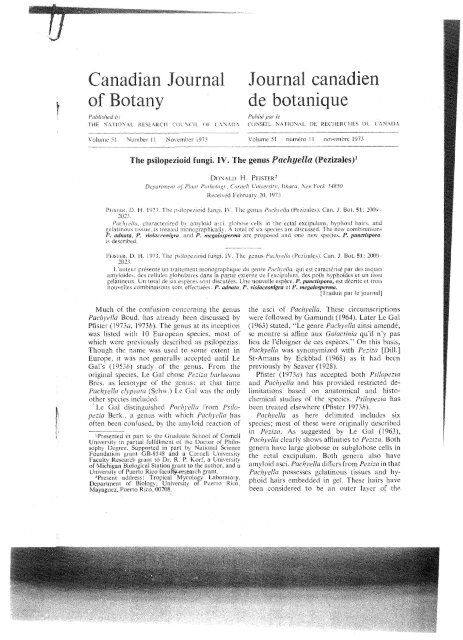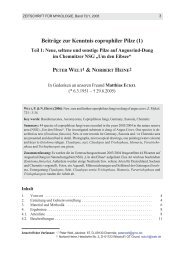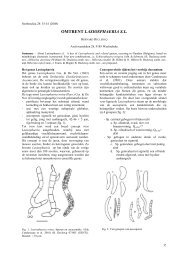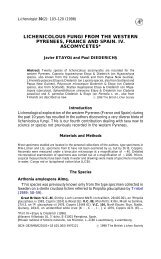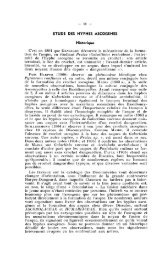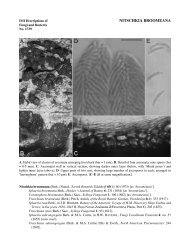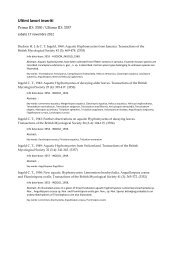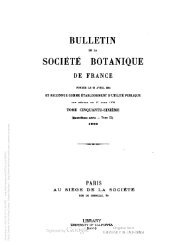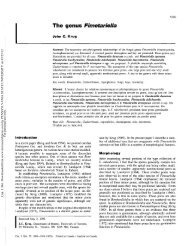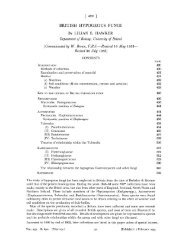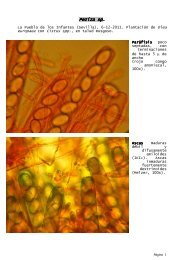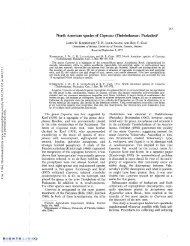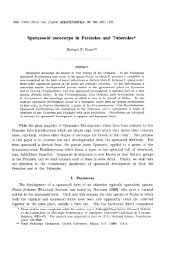Pfister-1973-The-psilopezioid-fungi-IV-Pachyella-0001 - ASCOfrance
Pfister-1973-The-psilopezioid-fungi-IV-Pachyella-0001 - ASCOfrance
Pfister-1973-The-psilopezioid-fungi-IV-Pachyella-0001 - ASCOfrance
You also want an ePaper? Increase the reach of your titles
YUMPU automatically turns print PDFs into web optimized ePapers that Google loves.
Published bi<br />
THE N' YTlON KL Ri-ShARC'H COl \CIL 0 1 C \\AD 1<br />
Volume 51 Number 1 1 November <strong>1973</strong><br />
/'i/h/;& par 1c'<br />
C'ONSEIL NATIONAL Dfc RECHERCHES DL CAN-\I34<br />
- -<br />
Volume 51 numb 1 1 iiovembre <strong>1973</strong><br />
Pf-I~TER. 13 H. 197.3. rhe p-iitoptvioici fung. I\'.<br />
2023.<br />
<strong>The</strong> genus Pu&ella (Pezizaies). Can. J. Bot. 51: 2009-<br />
/'~~ch\di~~, chaiactend (3) a q loid a'-ci. globose cell\ 111 the ectai excipulum. hyphoid hairh. and<br />
gelatinous tissue, is ~eated mono graphic all^. A total of six species are discussed. <strong>The</strong> new combinations<br />
P. adnar~. P. vidaceonigra. and P. megafospern~~~ aie pioposed and one ne\v specie's. P. puncfi~ora.<br />
is described<br />
'FISTLR. D. H. <strong>1973</strong>. <strong>The</strong> psilopc~iod <strong>fungi</strong>, <strong>IV</strong>. <strong>The</strong> genus Mi\ dlu (Pezszales). Can. J. Eot. 51 : 2009-<br />
2023.<br />
L'auteur pi6ente un tiaitement monogi aphique du genre Pmhj ella. qui est caractkrise par des asqueh<br />
amyloide;). des cellules glohiilasrcs dans la partie externe de l'excspulum, des poils hyphoides et un tissu<br />
gelatmeus. Un total iie ;)ix especes sont discutees. Une nouvelle espkce. P. pmctispora, est dkcri te et ti oi-i<br />
now elle;) combinakons ;>or1 i effec tuees : P. adr~ita.<br />
Much of the confusion concerning the genus<br />
Pacl~y~lla Boud. has already been discussed by<br />
<strong>Pfister</strong> (<strong>1973</strong>0, <strong>1973</strong>b). <strong>The</strong> genus at its inception<br />
was listed with 10 European species, most of<br />
which were previously described as psilopezias.<br />
Though the name was used to some extent in<br />
Europe, it was not generally accepted until Le<br />
Gal's (19536) study of the aenus. From. the<br />
original species, Le Gal chose Pezizc; barlaemu<br />
Bres. as lectotype of the 2;enus; at that time<br />
Pac?zyellci cl\peata (Sch~ .) Le Gal was the only<br />
other ~~eciesincluded.<br />
Le Gal distinpished Pcichjvli'u from Psilopezia<br />
Berk.. a genus with which Puchyellc~ has<br />
often been confused, by the amyloid reaction of<br />
-<br />
Presented in pan to the Graduate School of Cornell<br />
University iii partial fulfillment of the Doctor of Philosophy<br />
Degree. Supported in part by National Science<br />
Foundation grant GB-8548 and a Cornell University<br />
Faculty Research grant to Dr. R. P. Korf. a University<br />
of Michigan Biological Station grant to the author, and a<br />
University of Puerto Rico faculty-research grant.<br />
Present address : Tropical Mycology Laboratory,<br />
Department of Biology, University of Puerto Rico,<br />
Mayaguez, Puerto Rico, 00708.<br />
P. viu/uceon&a et P. mquiu~perma.<br />
[Traduit par le journal]<br />
the asci of Paclzyella. <strong>The</strong>se circumscriptions<br />
were followed by Gamundi (1964). Later Le Gal<br />
(1963) stated, "Le genre <strong>Pachyella</strong> ainsi amende,<br />
se montre si affine aux Golactima qu'il n'y pas<br />
lieu de 1'6loigner de ces espkces." On this basis,<br />
Pc1chyeUa was synonymized with Peziza [Dill. ]<br />
St-An~ans by Eckblad (1968) as it had been<br />
previously by Seaver (1928).<br />
<strong>Pfister</strong> (l97h j has accepted both Psilopezia<br />
and Paclzyella and has provided restricted de-<br />
limitations based on anatomical and histo-<br />
chemical studies of the species. Psilopezia has<br />
been treated elsewhere (<strong>Pfister</strong> <strong>1973</strong>6).<br />
Puchyella as here delimited includes six<br />
species; most of these were originally described<br />
in Paiza. As suggested by Le Gal (1963),<br />
Pcichyella clearly shows affinities to Peziza. Both<br />
genera have large globose or subglobose cells in<br />
the ectal excipulum. Both genera also have<br />
amyloid asci. <strong>Pachyella</strong> differs from Peziza in that<br />
<strong>Pachyella</strong> possesses gelatinous tissues and hy-<br />
phoid hairs embedded in gel. <strong>The</strong>se hairs have<br />
been considered to be an outer layer of the
201 0 CAN. J. BOT. VOL. 51, <strong>1973</strong><br />
excipulum by some authors (Eckblad 1968).<br />
Another distinction can be made on the basis of<br />
the ascus reaction in iodine solution. <strong>The</strong> asci of<br />
<strong>Pachyella</strong> are diffusely amyloid while those of<br />
Peziza generally have an apical amyloid ring.<br />
In species of both genera, the flesh of the apothe-<br />
cium sometimes becomes discolored when<br />
broken. <strong>The</strong> value of this characteristic in<br />
differentiating species of <strong>Pachyella</strong> is not known,<br />
since several of the species have not been seen in<br />
fresh condition.<br />
Undoubtedly there remain species of <strong>Pachyella</strong><br />
masquerading as pezizas. Because Peziza is a<br />
large, difficult genus, these species will probably<br />
remain concealed until comprehensive mono-<br />
graphic work is completed on Peziza.<br />
<strong>The</strong> species now included in <strong>Pachyella</strong> form a<br />
closely related group. <strong>The</strong>y all share the same<br />
general apothecial anatomy. Four of the species,<br />
P. adnata (Berk. & Curt.) Pfist., P. clypeata<br />
(Schw.) Le Gal, P. megalosperma (Le Gal) Pfist.,<br />
and P. violaceonigra (Rehm) Pfist., are distin-<br />
guished from one another by differences in their<br />
spore ornamentations; their apothecial anatomy<br />
is almost identical.<br />
Materials, methods, and terminology are those<br />
used by <strong>Pfister</strong> (<strong>1973</strong>b). When large numbers of<br />
specimens were examined, herbaria abbreviations<br />
and numbers alone are given rather than com-<br />
plete specimen citations.<br />
PACHYELLA Boud. emend. <strong>Pfister</strong><br />
=<strong>Pachyella</strong> Boud., Hist. Class. Discom. Eur .<br />
p. 50. 1907. (Lectotype species: Peziza<br />
barlaeana Bres. = <strong>Pachyella</strong> violaceonigra<br />
(Rehm) <strong>Pfister</strong>, selected by Le Gal 1953b.)<br />
=Peltidium Kalchb., Hedwigia, 2: 58. 1862.<br />
(Holotype species : Peltidium oocardii<br />
Kalchb.) non Peltidium Zoll. 1820 (Compositae).<br />
= Pulvinaria Velen., Mon. Discom. Boh. 1 :<br />
3 32. 1934. (Lectotype species : Peltidium<br />
oocardii Kalchb., selected by Eckblad 1968)<br />
non Pulvinaria Bonorden, 195 1 (Sphaeriales),<br />
nec Pulvinaria Rodway, 19 18 (Sphaeropsidales).<br />
Apothecia flat, generally broadly attached to<br />
the substrate, occasionally more centrally attached,<br />
0.4-8 cm in diam, becoming convoluted<br />
in some species, sometimes the apothecial flesh<br />
becoming yellow when broken, generally drying<br />
to a thin film; hymenium dark to pallid, some-<br />
times with vinaceous or reddish tints; on the<br />
outside pallid with grey or vinaceous tints,<br />
smooth and shining when fresh. Ectal excipulum<br />
with a discrete layer of textura globulosa to<br />
textura angularis, outer cells terminating in<br />
flexuous hairs which are embedded in a gela-<br />
tinous matrix. Medullary exciplum of textura<br />
intricata, either loosely woven or dense, J+ or<br />
J- gel present. Subhymenium not differentiated<br />
from the medullary excipulum, J+ or J-.<br />
Margin not present as a distinct zone, the hairs of<br />
the ectal excipulurn continuing (though some-<br />
times becoming shorter) toward the hymenium.<br />
Asci with a terminal operculum, without promi-<br />
nent croziers, usually J+, sometimes J- in dried<br />
material, contents sometimes golden in Melzer's<br />
reagent, eight-spored, long-cylindrical, 250-500<br />
X 15-20 p.m. Ascospores hyaline, ellipsoidal,<br />
mostly less than 25 pm long, smooth or variously<br />
marked with cyanophilic ornamentation, outer<br />
spore wall usually cyanophilic, two-guttulate,<br />
with or without deBary bubbles, uninucleate.<br />
Paraphyses septate clavate, generally with definite<br />
internal dark granules in the apical cells, neither<br />
branching nor anastornosing frequently.<br />
SUBSTRATE AND RANGE: Usually on water-<br />
soaked rotten wood, though occasionally on soil<br />
surrounding wood, or on other decaying plant<br />
parts, also on wood submerged in water; world-<br />
wide.<br />
NAME: From the Greek "pachy" thick or stout,<br />
and "ella," the diminutive suffix.<br />
NOTES: <strong>The</strong> asci of <strong>Pachyella</strong> species are usually<br />
amyloid. <strong>The</strong> nature of the amyloid material is<br />
not known chemically. <strong>The</strong> amyloid reaction is<br />
not restricted to the ascus; it is also present in the<br />
subhymenium and medullary excipulum of P.<br />
adnata. In <strong>Pachyella</strong> species, the amyloid mate-<br />
rial is present either as an external layer on the<br />
ascus wall (which may separate from the ascus<br />
wall proper), or occurs in the gel which sur-<br />
rounds the asci and paraphyses and is not re-<br />
stricted to the wall. Since the reaction is not<br />
restricted to the apex of the ascus, nor is it in the<br />
form of a J+ ring at the apex of the ascus as in<br />
Peziza, the reaction in <strong>Pachyella</strong> is said to be<br />
diffuse. This diffuse reaction is also common in<br />
the Ascobolaceae, which, however, can be dis-<br />
tinguished by their eguttulate spores.<br />
Le Gal (1953b) described the asci of <strong>Pachyella</strong><br />
babingtonii (Berk. & Br.) Boud. as J- and in-<br />
cluded the species in Psilopezia. Rehm (1 8%) and
on the<br />
is tints,<br />
(dpulum<br />
dosa to<br />
iting in<br />
a gela-<br />
textura<br />
. J+ or<br />
entiated<br />
or J-.<br />
hairs of<br />
h some-<br />
nenium.<br />
t promi-<br />
in dried<br />
Melzer's<br />
250-500<br />
ipsoidal,<br />
ariously<br />
n, outer<br />
uttulate,<br />
lucleate.<br />
I definite<br />
, neither<br />
1 water-<br />
y on soil<br />
ng plant<br />
- ; world-<br />
or stout,<br />
e usually<br />
Serial is<br />
action is<br />
,nt in the<br />
m of P.<br />
id mate-<br />
r on the<br />
he ascus<br />
ich sur-<br />
not re-<br />
ii is not<br />
it in the<br />
:us as in<br />
id to be<br />
nmon in<br />
1 be dis-<br />
'achyella<br />
and in-<br />
895) and<br />
* j<br />
Bayliss Elliott (1927) both had previously re-<br />
ported the asci as J+. Study of both fresh and<br />
dried material indicates the blueing is usually pres-<br />
ent in fresh material, but may be lacking in dried<br />
specimens. In this species the amyloid reaction is<br />
not restricted to the wall, but is present in the<br />
hymenial gel. Le Gal (19.536) was followed by<br />
Gamundi (1 964) and Eckblad (1 968) in her place-<br />
ment of <strong>Pachyella</strong> babingtonii in Psilopezia. Since<br />
anatomically and histochemically <strong>Pachyella</strong><br />
babingtonii agrees with the present delimitation<br />
of <strong>Pachyella</strong>, it is treated here in <strong>Pachyella</strong>.<br />
Ingold (1954), in his observation of <strong>Pachyella</strong><br />
babingtonii (as P. depressa (Phill.) Boud.), des-<br />
cribed the contents of the asci at one stage of<br />
developnlent as forming a granular mass which<br />
separates into eight parts, the parts becoming<br />
ascospores. Though the cytoplasm of the asci has<br />
been observed to become dense because of the<br />
presence of large granules, the direct origin of<br />
ascospores from this mass has not been ob-<br />
served. <strong>The</strong> contents of the asci of some species<br />
of Puchyella have been observed to become<br />
golden in Melzer's reagent. This phenomenon is<br />
most pronounced in P. babingtonii and P.<br />
clypeata.<br />
PFISTER: PSILOPEZIOID FUNGI<br />
KEY TO THE SPECIES OF <strong>Pachyella</strong><br />
Though never placed in the Sarcoscyphineae,<br />
<strong>Pachyella</strong> babingtonii has been described as hav-<br />
ing suboperculate asci (Le Gal 1953A). In this<br />
study of both fresh and dried material, no sub-<br />
operculum has been observed in this or any other<br />
species of <strong>Pachyella</strong>.<br />
<strong>The</strong> excipular structure distinguishes <strong>Pachyella</strong><br />
both from Peziza and from other operculate<br />
Discomycetes. In <strong>Pachyella</strong> there is always a well-<br />
developed cortical zone of globose to compressed<br />
globose cells which, on the outside, terminate in<br />
hyaline, hyphoid hairs. Gel is always present in<br />
the medullary excipulum and also surrounds the<br />
hairs. Excipular gel has been noted in <strong>Pachyella</strong><br />
babingtonii (as P. depressa) by Ingold (1954).<br />
Because of the large size of the excipular cells<br />
and the large amounts of gel in some species, the<br />
apothecia often collapse when dried. In P.<br />
babingtonii, dried apothecia are so poorly pre-<br />
served that almost no anatomical features re-<br />
main. Differences in apothecial anatomy may be<br />
used to distinguish species in some cases. Four<br />
species, P. aclnata, P. clypeata, P. megalosperm,<br />
and P. violaceonigra, have almost identica.<br />
excipular structure while P. babingtonii and PI<br />
punctispora Pfist. are both distinctive.<br />
A. Hyphoid hairs forming a palisade layer at the base of the apothecium ............................................................ B<br />
A. Hyphoid hairs not forming a discrete palisade layer at the base of the apothecium ........................................ E<br />
B. Ascospores smooth, apothecium umber to chestnut color ........................................................ P. clypeata<br />
...................................................................................................................<br />
B. Ascospores variously ornamented C<br />
C. Ascospores warted,warts large(greater than 1 pm high),each wart with parallel sides and flat top; apothe-<br />
cium umber to sepia (sometimes reddish) P. adnata<br />
C. Ascospores with smaller warts (less than lpm high) . D<br />
D. Warts anastomosing, hymenium reddish brown with yellow areas P. megalusperma<br />
D. Warts not anastomosing, hymenium dark brick to sepia P. violaceonigra<br />
E. Ascospores smooth or punctate, margin attached, apothecia less than 1 cm in diam .......... P. babingtonii<br />
E. Ascospores ornamented with fine warts, margin free, apothecia larger than 1 cm in diam P. punctispora<br />
ata (Berk. & Curt). <strong>Pfister</strong>, comb.<br />
nov. Fig. ld-f<br />
Â¥==Peziz adnata Berk. & Curt., J. Linn. Soc.<br />
Eot. 10: 365. 1869.<br />
=Discha adnata (Berk. & Curt.) Sacc., Syll.<br />
Fung. 8: 100. 1889.<br />
= Psilopezia trachyspora Ell. & Everh., Erythea<br />
1 : 200.1893.<br />
= Peziza pseudoclypeata Seaver, <strong>The</strong> North<br />
American cup-<strong>fungi</strong> (operculates). Supplemented<br />
ed. p. 332. 1942.<br />
Apothecium flat, sometimes becoming convo-<br />
luted, appressed, in age sometimes becoming<br />
shallow-cupulate, to 5 cm in diam, gregarious or<br />
scattered; hymenium umber to sepia, black when<br />
dried. Ectal excipulum textura globulosa, some-<br />
what compressed, 5-10 cells thick, outer cells<br />
25-40 pm in diam, terminating in hyphoid hairs,<br />
3-4 pm in diam, up to 400 pm long, embedded in<br />
gel, hairs sometimes slightly swollen at the tip.<br />
Medullary excipulum textura intricata, gel spar-<br />
ingly present, .?+ or J- , cells 5-22 pm in diam.
Asci diffusely J+, 387-450 x 18-20 pm. Asco-<br />
spores relatively thin-walled, ellipsoid, 10-1 2(- 14)<br />
X 18-20 pm (exclusive of markings), orna-<br />
mented with long blunt warts (exceeding 1 pn1<br />
in length), warts sometimes anastornosing, two-<br />
or sometimes one-guttulate (sometimes obscure),<br />
deBary bubbles absent. Paraphyses expanded at<br />
the tip to 6-9 pm, extending beyond the asci, the<br />
apical cells containing large dark granules, not<br />
reacting in Melzer's reagent.<br />
SUBSTRATE AND RANGE: On rotten, usually<br />
water-soaked wood; North America, the Carib-<br />
bean, and Japan.<br />
NAME: from the Latin 6'adnatus,'' broadly<br />
attached, referring to the broad attachment of the<br />
apothecium to the substrate.<br />
ILLUSTRATIONS: Cooke, Mycographia, 1. PI. 67,<br />
Fig. 259. 1879 (as Peziza adnata); Seaver, <strong>The</strong><br />
North American cup-<strong>fungi</strong> (operculates), sup-<br />
plemented ed. PI. 62. 1942 (as Peziza pseudo-<br />
clypeata).<br />
EXSICCATI : None.<br />
HOLOTYPE: Wright, Fungi Cubensis 658 (K).<br />
SPECIMENS EXAMINED : U.S.A. : Montana : on<br />
fallen log, Lake McDonald, Glacier Natl. Park,<br />
Montana, 19.VIII.1948, F. Korf and R. P. Korf<br />
(R.P.K. 1422). New York: on wood, Six-Mile<br />
Creek, near Ithaca, l7.X. 1960, R. P. Korf and<br />
E. J. Moore (R.P.K. 3087); on wood, Ringwood<br />
near Ithaca, 3 .X. 1960, R. P. Korf (R.P.K. 3093) ;<br />
rotting wood, Michigan Hollow, Danby,<br />
8.X.1956, L. R. Batra (R.P.K. 56-44). Ohio:<br />
Holotype of Peziza pseudoclypeata, on water-<br />
soaked log of Tilia americana, Cleveland (no<br />
date), Maurice B. Walters (NY = CUP 50905);<br />
on decayed sugar maple log, Cleveland, l5.VIII.<br />
1948, M. B. Walters (FH = CUP 51609). Penn-<br />
sylvania: wood, Bethlehem (no date), Schweinitz<br />
(PH, Schw. Syn. No. 765 = CUP 51619, CUP-<br />
D-3460, CUP-D-3849). Washington: Holotype<br />
of Psilopezia trachyspora, on rotten wood, North<br />
Bend, King Co., Aug. 1872, Adella M. Parker,<br />
No. 92 (NY = CUP-D-4644). Puerto Rico: on<br />
Cecropia peltata, El Yunque, 5.VI.1970, R. P.<br />
Korf et al. (CUP-PR-3844, NY); (as above)<br />
(CUP-PR-3847, NY); on fallen log of CyriZla<br />
racemiflora (as above) (CUP-PR-3852, NY) ; on<br />
fallen log of Cecropia peltata, El Yunque,<br />
lO.VI.1970, R. P. Korf et al. (CUP-PR-4007);<br />
on wood, El Yunque, January 24 to April 5,<br />
1923, F. J. Seaver and Carlos E. Chardon<br />
PFISTER: PSILOPEZIOID FUNGI<br />
(CUP-PR- 183 1, NY). CUBA : Wright, Fungi<br />
Cubensis No. 658 (K, FH). JAPAN: on dead wood<br />
(Shiia), 7.X. 1964, K. Tubaki (CUP-J-2904).<br />
TRINIDAD: on wood, Heights of Aripo, 16.111.1921,<br />
F. J. Seaver (NY).<br />
NOTES: Several collections of this species have<br />
asci which appear to be spirally thickened. This<br />
characteristic was mentioned by Seaver in his<br />
description of Psilopezia trachyspora. Since it has<br />
not been observed in fresh material, this is<br />
apparently an artifact produced by drying. <strong>The</strong><br />
large warts are characteristic of this species and<br />
distinguish it from the other species in the genus.<br />
This is the only species of <strong>Pachyella</strong> which may<br />
have J+ sterile tissue in the subhyrnenium and<br />
medullary excipulum. <strong>The</strong> significance of this<br />
characteristic is not known.<br />
<strong>The</strong> excipular structure is similar to that of<br />
P. clypeata, P. violaceonigra, and P. megalosperma.<br />
Morgan (1902) mistakenly synonymized<br />
Peziza adnata with P. clypeata.<br />
<strong>The</strong> distribution of the species is undoubtedly<br />
much more uniform than the collections cited<br />
above would indicate. I11 the north its fruiting<br />
time coincides with that of <strong>Pachyella</strong> clypeata',<br />
thus the two may be confused.<br />
<strong>Pachyella</strong> babingtonii (Berk. & Br.) Boud.<br />
Fig. la-f<br />
== Peziza babingtonii Berk. & Br., Ann. Mag.<br />
Nat. Hist. II,7 : 179. 1851 (ut "Babingtonii").<br />
= Psilopezia babingtonii (Berk. & Br.) Berk.,<br />
Outlines of Fungology. p. 373. 1860; as<br />
"(Berk. & Br.) Le Gal," Prodr. Flore Mycol.<br />
Madagascar, 4: 17 1. 1953.<br />
== Rlzizina babingtonii (Berk. & Br.) Massee,<br />
Br. Fung. Flora, 4: 455. 1895.<br />
=<strong>Pachyella</strong> babingtonii (Berk. & Br.) Boud.,<br />
Hist. Class. Discom. Eur. p. 51. 1907.<br />
= Peltidium oocardii Kalchb., Hedwigia, 2 : 58.<br />
1862 (ut "Oocardii").<br />
== Peziza oocardii(Ka1chb.) Karst., Myc. Fenn.<br />
1: 84. 1871.<br />
= Humaria oocardii (Kalchb.) Rehm in<br />
Rabenh. Kryptog-Fl. l(3): 954. 1894.<br />
Rhizina oocardii (Kalchb.) Massee & Crossl.,<br />
:<br />
Fungus Flora of Yorkshire p. 25 1. 1905.<br />
iPsilopezia oocardii (Kalchb.) Sacc. & D.<br />
Sacc., Syll. Fung. 18 : 11. 1906.<br />
== Pulvinaria oocardii (Kalchb.) Velen., Mon.
CAN. J. BOT. VOL. 51, <strong>1973</strong>
:<br />
PFISTER: PSILOPEZIOID FUNGI<br />
= Peziza rivularis Cr. & Cr., Florule du Finistere, drying to a thin film, up to 1 cm in diarn,<br />
p. 55. 1867 (non Peziza rivularis Clements. attached at the margin, gregarious to scattered;<br />
1894).<br />
=Humaria rivularis (Cr. & Cr.) Sacc., Syll.<br />
hymenium hazel to umber, drying<br />
- black. Ectal<br />
excipulum of textura globulosa, sometimes<br />
Fung. 8: 144. 1889.<br />
= <strong>Pachyella</strong> rivularis (Cr. & Cr.) Bond., Hist.<br />
slightly compressed, three to five cells thick,<br />
outer cells 20-60 pm in diam, terminating in<br />
Class. Discom. Eur. p. 5 1. 1907. hyphoid hairs 7-10 pm in diam and up to 100<br />
= Peziza oocardii (Kalchb.) Karst. var. lignaria pm long, embedded in gel, hairs shorter toward<br />
Karst., Mon. Fez. Fenn. p. 128. 1869.<br />
= Peltidium lignarium (Karst.) Hazsl., Oesterr.<br />
the margin than at the base of the apothecium.<br />
Medullary excipulum very loose textura intricata,<br />
Bot. Z. 32: 7. 1882. highly gelatinous, cells sometimes constricted at<br />
= Psilopezia myrothecioides Berk. & Br., Ann. the septa, 5-12 ,urn in diam. Asci J+ (or J - ,<br />
Mag. Nat. Hist. <strong>IV</strong>, 15: 39. 1875.<br />
= Rhizina myro thecioides (Berk. & Br.) Massee,<br />
especially in dried material), contents sometimes<br />
golden in Melzer's reagent, 250-325 X 15-20<br />
Br. Fung. Flora, 4: 455. 1895. pm. Ascospores thick-walled, broadly ellipsoid,<br />
=Humaria myrothecioides (Berk. & Br.) Boud., (9-)lo-16 X 17-23 pm, smooth or with small<br />
Hist. Class. Discom. Eur. p. 70. 1907. puncti, epispore highly cyanophilic, two- or<br />
= Peziza depresses Phill. in Cooke, Mycographia, sometimes one-guttulate (indistinct in some<br />
1 : 233. 1879 (non Peziza depressa Pers., cases), deBary bubbles sometimes present. Pura-<br />
1822). physes expanded at the tip to 7-1 5 pm extending<br />
=- Geoscypha depressa (Phill.) Rehm in Sydow. beyond the ascus, apically pigmented with small,<br />
Mycoth. March. No. 884. 1886. dark, highly cyanophilic granules.<br />
=Humaria depressa (Phill.) Sacc., Syll. Fung. SUBSTRATE AND RANGE: On water-soaked,<br />
8: 145. 1889. rotten logs, sometimes underwater, or on leaves<br />
=PachyelIa depressa (Phill.) Boud., Hist. and woody debris or on encrusted algae; cosmo-<br />
Class. Discom. Eur. p. 5 1. 1907. politan,<br />
= Peziza<strong>psilopezioid</strong>es Cooke & Phill., Grevillea, NAME: For Mr. Babington, collector of the<br />
9: 104. 1880. holotype.<br />
=Humaria <strong>psilopezioid</strong>es (Cooke & Phill.) ILLUSTRATIONS: Berkeley and Broome, Ann.<br />
Sacc., Syll. Fung. 8: 144. 1889. Mag. Nat. Hist. <strong>IV</strong>. 15, PI. 2, Fig. 5. 1875 (as<br />
= Peltidium cookei Hazsl., Oesterr. Bot. Z. 32:7. Psilopezia myrothecioides); Boudier, Icones My-<br />
1882. col. 2, PI. 312. 1910. (as <strong>Pachyella</strong> depressa);<br />
= Peziza saccharina Bres., Fungi Trid. 1 : 24. Bresadola, Fungi Trid. 1, Pl. 29, Fig. 1. 1882 (as<br />
1882. Peziza saccharina) ; Bresadola, Icon. Mycol. 25,<br />
dezicula saccharina (Bres.) Sacc., Michelia, PI. l237(l). 1933 (as Pezicula saccharim) ; Cooke,<br />
2: 536. 1878. Mycographia, 1, PI. 110, Fig. 392. 1879 (as<br />
dachyella saccharina (Bres.) Boud., Hist. Peziza depressa); Dennis, British Cup-Fungi,<br />
-<br />
Class. Discom. Eur. p. 5 1. 1907. PI. 4, k, 1960 (as Psilopezia babingtonii); Dennis,<br />
= Psilopezia bohemica ?elen., Ceskk Houby, British Ascomycetes, PI. 4, k, 1968 (as Psilopezia<br />
p. 879. 1922. babingtonii); Ingold, Trans. Br. Mycol. SOC. 37,<br />
=Pulvinaria bohemica (Velen.) Velen., Mon. Fig. 1. 1954 (as <strong>Pachyella</strong> depressa) ; Kalch-<br />
Discom. 1 : 332. 1934. brenner, Hedwigia, 2, PI. 10,3. 1862 (as Peltidium<br />
= =Humria oocardii (Kalchb.) Rehm var. stadleri oocardii); Le Gal, Prodr. Flore Mycol. Mada-<br />
Ade, Allg. Bot. Z. 30-3 1 : 2 1. 1925. gascar, 4: 174, 175. 1953 (as Psilopezia babing-<br />
= <strong>Pachyella</strong> depressa (Phill,) Boud. var. pallida tonii).<br />
Rea in Bayliss Elliott, Trans. Br. Mycol. Soc. EXSICCATI: Karsten, Fungi Fenn. No. 636<br />
12: 294. 1927. (as Peltidium oocardii var. lignaria); Rabenhorst,<br />
ezia albida Kanouse, Pap. Michigan Fungi Europ. No. 521 (as Peltidium oocardii).<br />
. Sci. 19: 99. 1934. HOLOTYPE: On rotten wood, Grace Dieu Wood,<br />
achyella dearnessii Gamundi, Darwinians, Lancashire, Great Britain, Rev. C. Babington<br />
(K).<br />
cizm flat, convex-pulvinate, appressed, SPECIMENS EXAMINED: u.s.A.: Idaho: MICH
2016 CAN. J. BOT.<br />
( = CUP 50962). Maryland: CUP 5 1573. Massa-<br />
chusetts: CUP 51625, 51626, 5 1615, 51636.<br />
Michigan : Holotype of Psilopezia albida, on<br />
sticks submerged in running water, Au Sable<br />
Falls, Grand Marais, Alger Co., 8.IX. 1932,<br />
. Mains (32-646), (MICH = CUP 50893),<br />
12 specimens in MICH, slides of which are<br />
deposited in CUP under the following accession<br />
numbers: CUP 50896, 50900, 50901, 50904,<br />
50950-50954,50957,50660,50963,50964, 52305.<br />
Minnesota: CUP-D- 10706. Montana: MICH<br />
(= CUP 50192). New York: CUP 52277, 52283,<br />
51620-51624, 51627-51634, 51637-51639, 51641,<br />
5 I642,5 l649,5 1650,52284,49856,49858,49859,<br />
52308, 52309, NY (= CUP 49546), R.P.K. 53-<br />
110, R.P.K. 53-22, R.P.K. 2745. Ohio: NY<br />
(= CUP 49548), R.P.K. 3966. Oregon: OSC<br />
25047, OSC 23944. South Carolina: CUP-D-<br />
2550. Vermont: CUP 51640. Virginia: CUP<br />
52303,52304. Washington : CUP 50897. AUSTRIA :<br />
Two specimens in the Herb. von Hohnel, FH,<br />
slides deposited = CUP 5 1610, 51 61 1 ; one<br />
specimen Herb. Rehm, S = CUP 50932. ARGEN-<br />
TINA: BAFC 20015 (= R.P.K. 2959). BELGIUM:<br />
Isotype of Peziza <strong>psilopezioid</strong>es, on rotten wood,<br />
Libert No. 895 (NY). CZECHOSLOVAKIA : Holo-<br />
type of Psilopezia bohemica, no substrate,<br />
Mnichovice: Mirosovicey VII.1926, J. Velen-<br />
ovsky (PR 150227 = CUP 52290), PR 152885<br />
(= CUP 52291), PR 152883 (= CUP 52288),<br />
PR 152886 (= CUP 52289). CANADA: Ontario:<br />
Holotype of <strong>Pachyella</strong> dearnessii, on wet rotten<br />
Three specimens in Herb. Rehm, S (= CUP<br />
50925, 5093 8, 5094 1). GREAT BRITAIN : Holotype<br />
of Peziza depressa, on willow on ground, July<br />
1878, W. Phillips (K. sub Peziza convexa Phill.),<br />
Holotype of Psilopezia myrothecioides, on Prunus<br />
padus, New Pitsligo, 1876, Rev. J. Fergusson<br />
(K), CUP-D-198, CUP 49544, one specimen<br />
Herb. Rehm, S (= CUP 50929). HUNGARY: One<br />
specimen in Herb. E. Fries, UPS ( = CUP 50923),<br />
Isotype of Peltidium oocardii, in Oocardio strata<br />
(Naig.) ad lapides submerses rivuli montani ad<br />
Olaszinurn Scepusii (Hungar, superioris), C.<br />
Kalchbrenner (Rabenh., Fungi europaei No.<br />
52 1 ; CUP, FH, BPI). INDIA: CUP-1-25, CUP-I-<br />
462. ITALY: Holotype of Peziza saccharina, ad<br />
Tiliae parvifoliae, 1882, Bresadola (Herb. Bresa-<br />
dola, S = CUP 50948). JAMAICA: CUP-MJ-313,<br />
CUP-MJ-3 14. JAPAN: CUP-J-1426, CUP-J-2738,<br />
CUP-J-2839. JAVA: CUP-SEA-470. SWEDEN: One<br />
specimen in UPS (= CUP 50917). VENEZUELA:<br />
Dumont-VE-243 and 2366 (NY).<br />
NOTES: This is the most common, most widely<br />
distributed, and most often described of the<br />
<strong>Pachyella</strong> species. Seaver's (1928) concept of<br />
Psilopezia nwnmdaria was based in part on specimens<br />
of this species. PachyelJa babingtonii has<br />
been placed in Psilopezia (Le Gal 1953 b ; Eckblad<br />
1968; Gamundi 1964) because the asci were<br />
thought to be J - .<br />
<strong>The</strong> species is quite variable in size, shape, and<br />
color of the apothecium. <strong>Pachyella</strong> babingtonii<br />
shows little substrate preference, occurring on<br />
wood, leaves, and encrusted algae. Fruit bodies,<br />
though sometimes found on water-soaked wood,<br />
are often situated below the surface of swiftly<br />
flowing water.<br />
Some specimens have ascospores which are<br />
punctate. <strong>The</strong> specimens with these spores are<br />
anatomically identical with those with smooth<br />
spores. <strong>The</strong> punctate spores occur in few collections<br />
and are few in number in any given specimen.<br />
<strong>The</strong> collections having these spores come<br />
wood, London, 3.VIII. 1889, J. Dearness (359) from throughout the geographic range of the<br />
(NY), CUP 52276, 51635, 51646. CHINA: CUP- species. It is thought that these puncta develop<br />
CH-322 (also duplicate specimen BPI). COSTA very late in the ontogeny of the spore and may<br />
RICA: CUP-CA-25, CUP-CA-53. FINLAND : Iso- characterize the completely mature spore.<br />
type of Peziza oocardii var. lignaria, ad lignum Type material of several synonymized species<br />
putridurn, Tavastia australis, Tammela, Mustiala, has not been seen. Peziza rivularis Cr. & Cr. is<br />
Fennia (Fung. Fern. No. 636, H == CUP 50946, synonymized here on the basis of Le Gal's<br />
FH), two specimens in H, slides deposited = (1953a) study of the holotype. <strong>Pachyella</strong> depressa<br />
CUP 50945, 50947. FRANCE: One specimen in var. pallida is synonymized on the basis of the<br />
Herb. Bresadola, S (= CUP 50949). GERMANY: original description, since type material has not<br />
been located at either the British Museum or<br />
Kew. Humaria oocardii var. stadleri was also<br />
synonymized on the basis of the original description,<br />
since Ade's specimens seem to have been<br />
destroyed during World War 11.<br />
<strong>Pachyella</strong> clypeata (Schw.) Le Gal Figs. la-c, 3<br />
= Peziza clypeata Schw., Schrift. Naturf. Ges.<br />
Leipzig, 1 : 1 17. 1822 (non Peziza clypeata<br />
Boud. ex. Sacc. 1889).
ntani ad<br />
Iris), C.<br />
aei No.<br />
CUP-I-<br />
rina, ad<br />
1. Bresa-<br />
J-3 13,<br />
-J-2 73 8,<br />
EN: One<br />
ZZUELA :<br />
- widely<br />
of the<br />
:ept of<br />
n speci-<br />
nii has<br />
ckblad<br />
1 were<br />
Ie, and<br />
ngtonii<br />
ng on<br />
Iodies,<br />
wood,<br />
swiftly<br />
-h are<br />
2s are<br />
nooth<br />
ollec-<br />
speci-<br />
come<br />
f the<br />
velop<br />
may<br />
)ecies<br />
3. is<br />
3al's<br />
wssa<br />
f the<br />
not<br />
a or<br />
also<br />
;rip-<br />
3een<br />
-c, 3<br />
Jes.<br />
PFISTER : PSILOPEZIOID FUNGI
201 8 CAN. J. BOT. VOL. 51, <strong>1973</strong><br />
== Discina clypeata (Schw.) Sacc., Syll. Fung.<br />
8: 101. 1889.<br />
= <strong>Pachyella</strong> clypeata (Schw.) Le Gal. Prodr.<br />
Flore Mycol. Madagascar, 4: 27. 1953.<br />
=Bulgaria bicolor Peck, Ann. Rep. N.Y. State<br />
Mils. 32: 49. 1879.<br />
deziza orbicularis Peck, Bull. N.Y. State<br />
Mus. 1 : 20. 1887. (a name change, non<br />
Peziza bicolor Bull. ex Fr. 1822).<br />
= Discina orbicularis (Peck) Sacc., Syll. Fung.<br />
8: 103. 1889.<br />
Psilopezia orbicularis (Peck) Dodge, Trans.<br />
:<br />
Wis. Acad. Sci. 17: 1052. 1914 (ut "Psilop<br />
eziza ' ' ) .<br />
Apothecium flat, sometimes becoming convoluted,<br />
appressed, in age sometimes becoming<br />
shallow cupulate, up to 8 cm in diam, flesh<br />
sometimes becoming yellow when broken, pallid<br />
to glaucous grey on the outside, gregarious to<br />
scattered; hymeniurn umber to chestnut. Ectal<br />
excipulum textura globulosa, somewhat compressed,<br />
three to five cells thick, outer cells 10-30<br />
pm in diam, terminating in hyphoid hairs up to<br />
400 pm long, hairs sometimes pigmented and<br />
swollen at the tip, hairs embedded in gel.<br />
Medullary excipulum dense textura intricata, gel<br />
sparingly present, hyphae 3-16 pm in diam. Asci<br />
diffusely J+ , rarely J - , 387-500 X 20-25 prn.<br />
Ascospores at maturity : hyaline, thin-walled,<br />
smooth, ellipsoid, 13-16 X 18-25(28) pm, twoguttulate,<br />
guttules sometimes appearing granular<br />
or resinous, deBary bubbles sometimes present.<br />
Paraphyses expanded at the tip to 10 urn, extending<br />
beyond the asci, pigmented with large, dark,<br />
internal amorphous granules in the apical cell,<br />
granules becoming reddish purple in Melzer's<br />
reagent (in fresh material).<br />
SUBSTRATE AND RANGE: On rotten logs and<br />
stumps, mostly water-soaked; North America<br />
and Japan.<br />
NAME: From the Latin "clypeatus," like the<br />
circular Roman shield (clypeus) ; referring to the<br />
form of the apothecia.<br />
ILLUSTRATIONS: Peck, Ann. Rep. N.Y. State<br />
Mus. 32. PI. 2, Figs. 4-6. 1879 (as Bulgaria bicolor).<br />
Peck, Bull. N.Y. State Mus. 1. PI. 2,<br />
Figs. 4-6. 1 887 (as Peziza orbicularis). Seaver,<br />
Mycologia, 8. PI. 191. 1916. Seaver, North<br />
American cup-<strong>fungi</strong> (operculates). PI. 34. 1928.<br />
EXSICCATI: Ellis and Everhart, North American<br />
Fungi, No. 568 (as Psilopezia nwnmularia).<br />
HOLOTYPE: Synopsis Fungorum Carolinae<br />
Superioria No. 1170 (PH = CUP-D-3839, CU<br />
50 198).<br />
SPECIMENS EXAMINED : U.S.A. : Delaware : CUP-<br />
D-4638. Illinois : CUP-D- 10838. Indiana : CUP-<br />
D-2688, NY (= CUP 49550). Hawaii: BPI<br />
(Shear). Iowa: CUP-D-4641. Maine: NY (=<br />
CUP 49553). Michigan: CUP 5 1535. Nebraska:<br />
CUP-D-109 14. North Carolina: CUP 52279.<br />
New York: CUP 51534, 51536, 51562, 51564,<br />
5 1620,5 1621,52278,52297-52301,22991, 19472,<br />
2955, 15889, 43155, 35988, 33105,25724, 37254,<br />
36692, 22987, CUP-A-3 16, CUP-D-3 54, CUP-<br />
D-463 5, CUP-D-653, CUP-D- 1003, CUP-D-<br />
1031, CUP-D-1068, CUP-D-1211, CUP-D-1637<br />
CUP-D- 1740, CUP-D- 1769, CUP-D- 1802, CUP-<br />
D-9580, Isotype of Bulgaria bicolor, on wet<br />
decaying birch wood, Brewerton, Sept., Dr. Peck<br />
(CUP-D-3026), CUP-D-5778, CUP-D-6 19 1,<br />
R.P.K. 53-224, R.P.K. 53-228, R.P.K. 53-242,<br />
R.P.K. 54-36, R.P.K. 55-1, R.P.K. 335, R.P.K.<br />
796, R.P.K. 1696, R.P.K. 1992, R.P.K. 2676,<br />
R.P.K. 2715, R.P.K. 2719, R.P.K. 2864, R.P.K.<br />
3242, NY (= CUP 49549). Ohio: CUP-D-2706,<br />
CUP-D-2 137, R.P.K. 400 1. Pennsylvania : CUP-<br />
A-2 1 573, CUP-A-(no number, collected by<br />
Ravenel), CUP-D-9223, CUP-D-5 122. South<br />
Carolina: CUP-D-3445, CUP-D-2755, CUP-D-<br />
3443, CUP-D-3350, UPS Herb. E. Fries (=<br />
CUP 50920). Tennessee: CUP 52280 - CUP<br />
52282. CANADA: Ontario: CUP 51563, CUP-<br />
D-4636, CUP-D-4639. JAPAN: CUP-J-1824.<br />
NOTES: This is the largest of the <strong>Pachyella</strong><br />
species and is commonly collected. It is ana-<br />
tomically similar to P. violaceonigra, P. adna fa,<br />
and P. megalosperma, but is easily distinguished<br />
by its smooth spores. Its distribution in North<br />
America and Japan coincides with that of P.<br />
FIG. 4. a-c. Camera-lucida drawings of the ascospores<br />
of <strong>Pachyella</strong> megalosperma. X 1000. Drawn from the<br />
holotype.
39, CUP<br />
: CUP-<br />
i: CUP-<br />
ii: BPI<br />
NY (=<br />
braska :<br />
52279.<br />
5 1564,<br />
, 19472,<br />
37254,<br />
In wet<br />
r. Peck<br />
1-6191,<br />
3-242,<br />
-LP.K.<br />
2676,<br />
W.K.<br />
-2706,<br />
CUP-<br />
d by<br />
CUP-<br />
hyella<br />
ana-<br />
hata,<br />
ished<br />
forth<br />
)f P.<br />
^<br />
J<br />
adnata. Recently I have seen photographs of a<br />
specimen from India which also appears to be<br />
P. clypeata. Seaver (1928) treats this species as<br />
Peziza clypeata.<br />
a (Le Gal) <strong>Pfister</strong>, comb.<br />
nov. Fig. 4a-c<br />
= Galactinia inegalosperma Le Gal, Prodr.<br />
Flore Mycol. Madagascar, 4: 63. 1953. A<br />
name change, non Galactinia macrospora<br />
(Wallr .) Boud.<br />
==. Galactinia pseudosuccosa Le Gal forma<br />
macrospora Le Gal, Rev. Mycol. lO(5-6):<br />
95. 1945.<br />
deziza megulosperma (Le Gal) Eckblad,<br />
Nytt Mag. Bot. 15 : 76. 1968.<br />
Apothecia flat, sessile, becoming somewhat<br />
convoluted and lobed, smooth, blue gray on the<br />
outside, exuding a yellow juice when broken;<br />
hynzenium according to Le Gal "brun roux<br />
brillant" with yellow zones. Ectal excipulum of<br />
globose to elongate cells intermixed with fila-<br />
mentous cells, the globose and elongate cells<br />
reaching a diameter of 32-40 pm, these cells<br />
become smaller toward the outside, and termi-<br />
nate in hyphoid hairs, 5-7 pm in diam, 165-198<br />
pm long, hairs sometimes densely cytoplasmic,<br />
embedded in gel. Medullary excipulum of closely<br />
woven textura intricata, the cells reaching a<br />
diameter of 5-9.6(12.8) pm, occasionally globose<br />
swellings up to 24 pm in diameter present. Sub-<br />
hymenium 50-60 pm thick, composed of globose<br />
and filamentous cells, the walls of which may be<br />
slightly pigmented. Asci J+ (in some cases<br />
slight), long cylindrical, 330-500 X 19-24 /mi.<br />
Ascospores ellipsoid, sometimes almost subfusi-<br />
form (20.5)22.5-28.5 X 10.5-14.5 pm. Para-<br />
physes expanded at the tip to 8-10 pm, filled<br />
apically with dark granules (appearing at times<br />
to be embedded in a gelatinous matrix).<br />
SUBSTRATE AND RANGE: On rotten wood,<br />
among mosses. Madagascar.<br />
NAME: From greek "megus,^ large, and<br />
'sperm," seed or spore, referring to the large<br />
ascospores.<br />
ILLUSTRATIONS: Le Gal, Rev. Mycol. 10. Figs.<br />
1 and 2. 1945. Le Gal, Prodr. Flore Mycol.<br />
Madagascar, 4. Figs. 22-25. 1953.<br />
EXSICCATI : None.<br />
HOLOTYPE: "Ad vetus lignum putridum mus-<br />
cisque coopertum, la fort3 de Fotsialana, Ie 12<br />
novembre 1934." Madagascar.<br />
PFISTER : PSILOPEZIOID FUNGI 2019<br />
SPECIMENS EXAMINED : MADAGASCAR : Sur bois<br />
pourri, for& Fotsialana, 12 novembre 1934, leg.<br />
R. Heim.<br />
NOTES: I find the specimen much as described<br />
by Le Gal (1953b) except for some differences in<br />
measurements. In the only specimen available<br />
to me for study, I found no spores with measure-<br />
ments as large as those listed by Le Gal, though<br />
the spores present appeared to be completely<br />
mature. I did not observe the anastomosis of<br />
paraphyses illustrated and described by Le Gal.<br />
<strong>The</strong> apothecial anatomy agrees perfectly with<br />
that of P. adnata, P. violaceonigra, and P.<br />
clypeata, from which P. megalosperma differs in<br />
its type of spore ornamentation. Eckblad (1968)<br />
included this species in Peziza and stated that the<br />
anatomy "differs slightly from the rest of the<br />
genus [Peziza]."<br />
This species seems rare. It will most likely be<br />
confused with P. violaceonigra, but in that<br />
species the spores are finely marked with small<br />
isolated cyanophilic dots which do not anasto-<br />
mose.<br />
ellapnetisporn <strong>Pfister</strong>, sp. nov. Fig. 5a-d<br />
Apothecium bubalinum, usque ad 2.5 cm<br />
diam, planum. Asci cylindracei, jodo caeru-<br />
lescentes, usque ad 450 pm longi, 19-25 pm diam,<br />
octospori. Ascospori ellipsoidei, biguttulati, 12-<br />
15 X 2 1-25 pm, verrucati, hyalini. Paraphyses<br />
usque ad 8 pm diam, rectae, brunneae.<br />
TYPUS: On wet wood, Gorge of Carp Creek,<br />
Cheboygan Co., Michigan, 27.VI.1969, N. J.<br />
Smith (CUP 52285).<br />
Apothecium flat to concave, attached broadly<br />
but margins free, reaching a diameter of 2.5 cm,<br />
gregarious to scattered, hymenium bay to umber<br />
sometimes with vinaceous tints. Ectal excipulum<br />
textura globulosa to angularis, up to s& cells<br />
thick, merging on the inside almost impercep-<br />
tibly with the medullary excipulum; outer cells<br />
(especially toward the base) 20-40 pm in diam,<br />
terminating in short hyphoid, septate, some-<br />
times appressed hairs up to 5 pm in diam, hairs<br />
longer at point of attachment, sometimes inter-<br />
woven, embedded in gel. Medullary excipulum<br />
textura intricata, gel present, cells short, some-<br />
times constricted at the septa, 5-7 pm in diam.<br />
Asci diffusely J+, contentssometimes becomi<br />
golden in Melzer's reagent, (375-)400-450 X 1<br />
25 jinn. Ascospores ellipsoid, 12-15 X 21-25 pm,<br />
marked with minute cyanophilic warts, one-
CAN. 1. BOT. VOL. 51, <strong>1973</strong>
guttulate, more commonly two-guttulate, deBary<br />
bubbles absent. Paraphyses expanded at the tip<br />
to 8 pm, extending beyond the asci to form a thin<br />
epithecium, with internal dark granules in the<br />
apical cells, granules not reacting in iodine.<br />
SUBSTRATE AND RANGE: On water-soaked<br />
rotten wood. New York, Michigan, and Illinois.<br />
NAME: From Latin "punctus," dotted, and<br />
'spora," spore, referring to the spore surface.<br />
ILLUSTRATIONS : None.<br />
EXSICCATI : None.<br />
HOLOTYPE: On wet wood, Gorge of Carp<br />
Creek, Cheboygan Co., Michigan, 27.VI.1969,<br />
N. J. Smith (CUP 52285).<br />
SPECIMENS EXAMINED: U.S.A. : Illinois: (NO sub-<br />
strate), Glencoe, VI. 1903, E. T. and S. A. Harper<br />
(S, Herb. Rehm = CUP 50924). Michigan: On<br />
wet wood, Gorge of Carp Creek, Cheboygan Co.,<br />
27.VI. 1969, N. J. Smith (Holotype CUP 52285);<br />
on rotten wood, Carp Creek Gorge, UMBS,<br />
Cheboygan Co., 7.IX.1969, N. J. Smith (2324)<br />
(CUP 52265) ; on moss-covered wood, Reese's<br />
Bog near UMBS, Cheboygan Co., 30.VII. 1969,<br />
N. J. Smith (CUP on rotten wood,<br />
Reese's Bog near Cheboygan Co.,<br />
30.VIL 1969, N. J. S P 52267); as above<br />
(CUP 52268); as above (CUP 52269); on water-<br />
soaked wood, Carp Creek<br />
Cheboygan Co., 3.VII. 1969<br />
52270); on wood in runnin<br />
near UMBS, Cheboygan Co., 8.VIII. 1969, D. H.<br />
<strong>Pfister</strong> and E. Wells (CUP 5227 1); on wet wood,<br />
y as above, 30.VII.1969, N. J. Smith<br />
52272); on wet wood, Tahquamenon Falls<br />
Park, at lower falls, 15.VIII.1969, D. H.<br />
ster (CUP 52273); on water-soaked wood,<br />
Carp Creek Gorge, Cheboygan Co., 7.1X.1969,<br />
J. Smith (CUP 52275); on wood, Old Saw<br />
ill N. of Burt Lake, Cheboygan Co., 8.VII.<br />
67, N. J. Smith (1 94) (CUP 50965, MICH); on<br />
ood, the Gorge, UMBS, Cheboygan Co.,<br />
12.VII.1967, N. J. Smith (237) (CUP 50958,<br />
MICH). New York: On wet wood, Pack Forest,<br />
Warrensburg, 28.1X.1969, R. P. Korf, D. H.<br />
xon (CUP 52307).<br />
istically this species is more<br />
an other species of <strong>Pachyella</strong>,<br />
res and short hairs em-<br />
be mistaken for a Peziza<br />
be transitional between<br />
pie P. babingtonii and the<br />
PFISTER: PSILOPEZIOlD FUNGI 202 1<br />
other larger more complex species of the genus.<br />
It is probably more common than the number of<br />
specimens listed here indicates. Since it re-<br />
sembles a Peziza in its attachment and coloration,<br />
and since Peziza species are seldom properly<br />
identified, more specimens are likely located<br />
among the unknown pezizas of various herbaria.<br />
<strong>Pachyella</strong> violaceonigra (Rehm) <strong>Pfister</strong>, comb.<br />
nov. Fig. lg-i<br />
= Pustularia violaceonigra Rehm, Hedwigia,<br />
2 1 : 98. 1882 (ut "violaceo-nigra").<br />
Â¥ Humaria violaceonigra (Rehm) Sacc., Syll.<br />
Fung. 8 : 150. 1889.<br />
=Plicaria violaceonigra (Rehm) Rehm in<br />
Rabenh. Kryptog-Fl. l(3): 1007. 1894.<br />
=Peziza barlaeana Bres., Fungi Trid. 2: 74.<br />
1898 (ut "Barleana").<br />
dachyella barlaeana (Bres.) Boud., Hist.<br />
Class. Discom. Eur. p. 50. 1907 (ut "Bar-<br />
laeana"),<br />
== Aleuria barlaeana (Bres.) Bres., Icon. Myco-<br />
logia, 25. PI. 1202. 1933 (ut "Barlaeana").<br />
Apothecium flat, becoming somewhat convo-<br />
luted, appressed, the margin sometimes turned<br />
up, to 5 cm in diam; hymenium dark brick to<br />
sepia (from Boudier's plate), drying black. Ectal<br />
excipulum textura globulosa, somewhat com-<br />
pressed, three to five cells thick, outer cells 25-55<br />
pm in diam, terminating in hyphoid hairs 3-5 pm<br />
in diam, embedded in gel, hairs up to 400 pm<br />
long, not swollen at the tip. Medullary excipulum<br />
dense textura intricata, becoming less dense to-<br />
ward the ectal excipulum, gel sparingly present,<br />
cells 5-1 2 pm in diam. Asci diffusely J+ , 4 10-<br />
425 X 19-20 pm. Ascospores thin-walled, ellip-<br />
soid, I 9-27 X 1 1-13 pm, marked with fine<br />
cyanophilic warts which do not anastomose,<br />
- -<br />
two-guttulate, deBary bubbles sometimes pre-<br />
sent. Paraphyses expanded at the tip to 8 pm,<br />
extending beyond the asci, the apical cells con-<br />
- .<br />
taining amorphous dark granules, granules not<br />
reacting in Melzer's reagent.<br />
SUBSTRATE AND RANGE : On moss-covered wood<br />
and on soil, Europe.<br />
NAME: From Latin "violaceous," violet, and<br />
"niger," black, especially glossy black.<br />
ILLUSTRATIONS : Boudier, Icones Mycol. 2. PI.<br />
3 10. 19 10 (as PachyeUa barlaeana); Bresadola,<br />
Fungi Trid .2. PI. 1 8 7. 1 898 (as Peziza barlaeana) ;<br />
Bresadola, Icon. Mycologia, 25. PI. 1202. 1933<br />
(as Aleuria barlaeana).
2022 CAN. J. BOT, VOL. 51, <strong>1973</strong><br />
EXSICCATI : None.<br />
HOLOTYPE: Auf faulen Holz und der daneben<br />
befindlichen Erde, Alpen bei Partenkirchen, bei<br />
Munchen, IX. 1874. Arnold (S, Herb. Rehm =<br />
CUP 50934).<br />
SPECIMENS EXAMINED : AUSTRIA: On wood and<br />
soil, Vorarlberg, IX.1897, (no collector) (S,<br />
Herb. Rehm). FRANCE: Holotype of Peziza<br />
barlaeana (no substrate), Nice (no date), M.<br />
Barla (PC = CUP 52293). GERMANY: (Substrate<br />
and locality unknown), VII.1887, Dr. Arnold<br />
(S, Herb. Rehm = CUP 50943). RUSSIA: Ad<br />
truncum putridurn, Tsebelda, Furjerosvoje<br />
(Alchariaj, 20.111.1912, G. Woronow (S, Herb.<br />
Rehm = CUP 50942). SWITZERLAND: Kant<br />
Graubunden : Arosa, Seetobelbach, 2 1 .VII. 1961,<br />
E. Rahm (UPS = CUP 50922); (same as above),<br />
30.IX. 196 1, E. Rahm (UPS = CUP 5092 1).<br />
NOTES: Pustularia violaceonigra, published in<br />
1882, is conspecific with Peziza barlaeana Bres.,<br />
published in 1898. It thus provides an older name<br />
for PachyeUa barlaeana. <strong>Pachyella</strong> barlaeana<br />
was selected as type of <strong>Pachyella</strong> by Le Gal<br />
(1 9536). Anatomically this species is nearly<br />
identical in excipular structure with P. clypeata,<br />
P. adwta, and P. megalosperma. <strong>Pachyella</strong><br />
violaceonigra appears to be limited to Europe<br />
whereas P. clypeata is primarily North American.<br />
<strong>Pachyella</strong> clypeata always occurs on rotten wood,<br />
but P. violaceonigra is sometimes found on soil.<br />
<strong>The</strong> other species which it closely resembles, P.<br />
adnata and P. megalosperma, both differ in the<br />
form of their spore markings.<br />
1. <strong>Pachyella</strong> barlaeana (Bres.) Boud. var. steven-<br />
, pro synon. (ut "Stephen-<br />
nsoniana (Ellis in Rehm ex<br />
Rabenh. Kryptog.-Fl. l(3) :<br />
t "Stevensoniana (Ellis j<br />
niana Ellis ex Mussat in<br />
Sacc., Syll. Fung. 15: 126. 1901, pro synon.<br />
(ut Wephensoniana Ellis").<br />
This taxon was synonymized by Seaver (1928)<br />
with Peziza repanda Pers. ex Pers. Examination<br />
of an isotype specimen (Oct. 11, 1878, W. C.<br />
Stevenson 320, CUP-D-447) indicates that his<br />
conclusions were correct.<br />
2. <strong>Pachyella</strong> melaleuca (Bres.) Boud., Hist. Class.<br />
Discom. Eur. p. 51. 1907.<br />
~Discina melaleuca Bres., Fungi Trid. 2:<br />
74. 1898.<br />
deziza melaleuca (Bres.) Seaver, North<br />
American cup-<strong>fungi</strong> (operculates). p. 225.<br />
1928.<br />
= Paradiscina melaleuca (Bres.) Benedix, Die<br />
Kulturpflanze, 17: 255. 1969.<br />
Despite the smooth, non-apiculate spores, this<br />
species is here referred to Discina on the basis of<br />
its apothecial anatomy. This species is also the<br />
type of the genus Paradiscina Benedix.<br />
HOLOTYPE EXAMINED : Sub Pino ~ylvestri,<br />
Gocciador, Italy, 1897, Bresadola (Herb. Rehm,<br />
S = CUP 50937).<br />
3. <strong>Pachyella</strong> rhizinoides (Rabenh.) Boud.. Hist.<br />
Class. Discom. Eur. p. 51. 1907.<br />
= Fleischhakia rhizinoides Rabenh., Hedwigia,<br />
17: 114. 1878.<br />
== Psilopezia rhizinoides (Rabenh.) Rehm,<br />
Rabenhorst Kryptog.-Fl. l(3) : 1 137. 1895.<br />
Neither type nor authentic material has been<br />
located. This taxon has been treated by Hennings<br />
(1903) and Rehm (1895) as a species of Psilo-<br />
pezia. It was synonymized with P. nummularia by
, pro synon.<br />
eaver (1 928)<br />
examination<br />
tes that his<br />
Hist. Class.<br />
;i Trid. 2:<br />
ver, North<br />
:s). p. 225.<br />
:nedix, Die<br />
spores, this<br />
:he basis of<br />
is also the<br />
sylvestri,<br />
x-b. Rehm,<br />
xid., Hist.<br />
Hedwigia,<br />
) Rehm,<br />
37. 1895.<br />
has been<br />
ennings<br />
of Psilo-<br />
nularia by<br />
the loan<br />
la : Royal<br />
Museum,<br />
Jaturelle,<br />
/, Stock-<br />
, Ham-<br />
Helsinki ;<br />
titute of<br />
Ippsala ;<br />
delphia ;<br />
PFISTER: PSILOPEZIOID FUNGI<br />
National Fungus Collections, Beltsville ; and LE GAL, M. 1953a. Les Discomycktes de l'herbier<br />
Crouan. Rev. Mycol. (Paris), 18: 73-132.<br />
<strong>The</strong> Farlow Herbarium and Library of Crypto- 19536. Les Discomyc~tes de Madagascar.<br />
gamic Botany, Cambridge.<br />
Prodr. Flore Mycol. Madagascar, 4: 1-465.<br />
<strong>The</strong> author also thanks Dr. Richard P. Korf 1963. Valeur taxonomique particulikre de<br />
certains caracteres chez Ie Discomycktes sugkrieurs.<br />
for his guidance throughout this study and Bull. Soc. Mycol. (France), 79: 456-470.<br />
cathleen <strong>Pfister</strong> for proofreading the manuscript. MORGAN, A. P. 1902. <strong>The</strong> discomycetes of the Miami<br />
Valley, Ohio. J. Mycol. 8: 179-180.<br />
BAYLISS ELLIOTT, J. S. 1927. Studies in Discomycetes. PFISTER, D. H. <strong>1973</strong>~. <strong>The</strong> <strong>psilopezioid</strong> <strong>fungi</strong>. I. His-<br />
<strong>IV</strong>. Trans. Br. Mycol. SOC. 12: 290-294.<br />
tory, nomenclature, and delimitation of the psil-<br />
ECKBLAD, F.-E. 1968. <strong>The</strong> genera of the operculate opezioid genera. Mycologia, 65 (2) : 32 1-328.<br />
discomycetes. A re-evaluation of their taxonomy, -- <strong>1973</strong>6. <strong>The</strong> <strong>psilopezioid</strong> <strong>fungi</strong>. 111. <strong>The</strong> genus<br />
phylogeny and nomenclature. Nytt Mag. Bot. 15: Psilopezia (Pezizales) . Am. J. Bot. 60 (4) : 355-3 65.<br />
1-191.<br />
REHM, H. 1887-1 896. Ascomyceten: Histeriaceen und<br />
GAMUNDI, I. J. 1964. "Discomycetes" operculados del Discomyceten. In Dr. L. Rabenhorst's Kryptogamen-<br />
Nahuel Huapi, Darwinians (Buenos Aires) , 13 : Flora von Deutschland, Oesterreich und der Schweiz.<br />
580-591.<br />
Vol. 1. Part 3. Edited by G. Winter and H. Rehm.<br />
HENNINGS, P. 1903. Einige neue und interessante pp. 1-1275.<br />
deutsche Pezizeen 11. Hedwigia, 42: 17-20.<br />
SEAVER, F. J. 1928. <strong>The</strong> North American cup-<strong>fungi</strong><br />
INGOLD, C. T. 1954. Aquatic Ascomycetes: Discomy- (operculates) . Published by the author, New York,<br />
cetes from lakes. Trans. Br. Mycol. Soc. 37: 1-18. N.Y.


